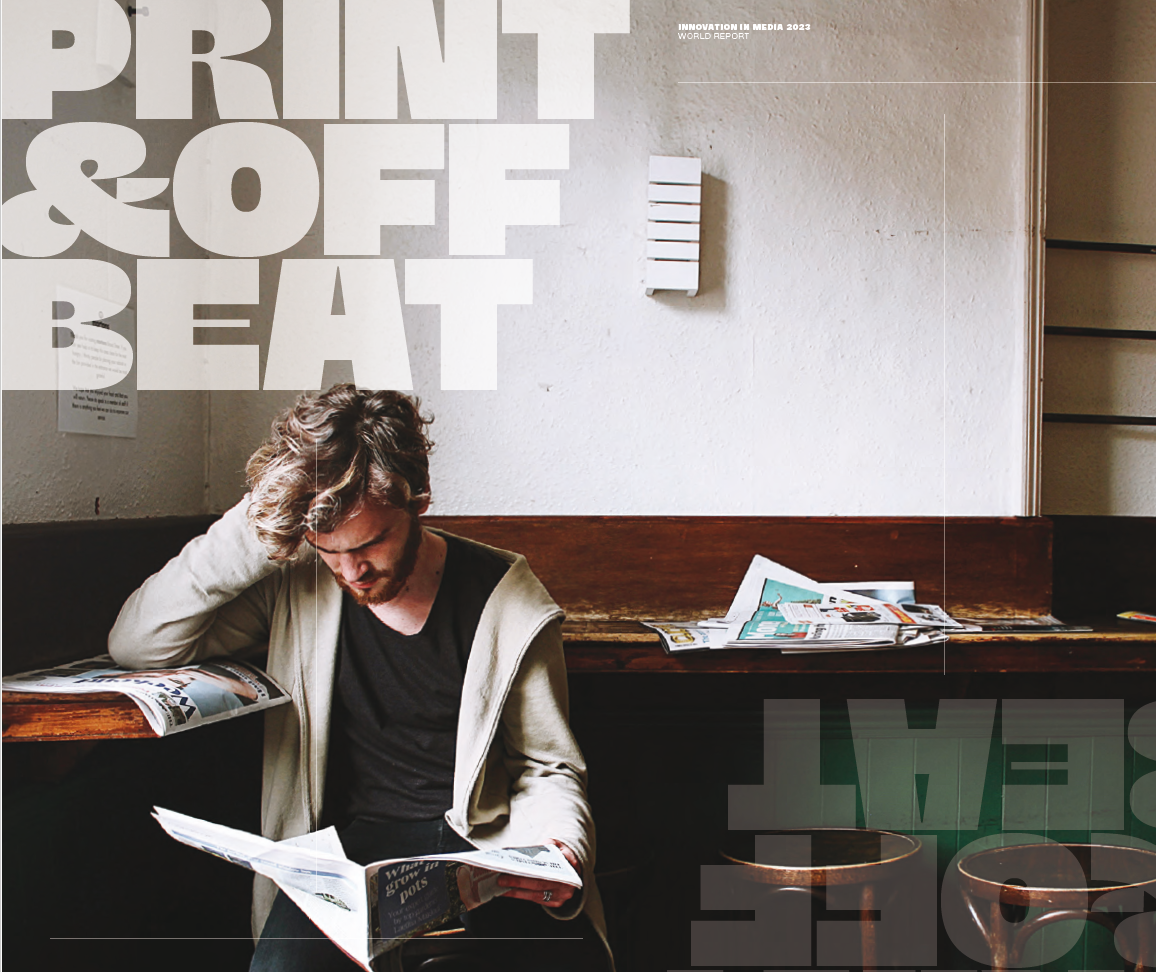
05 Nov Print & Off Beat
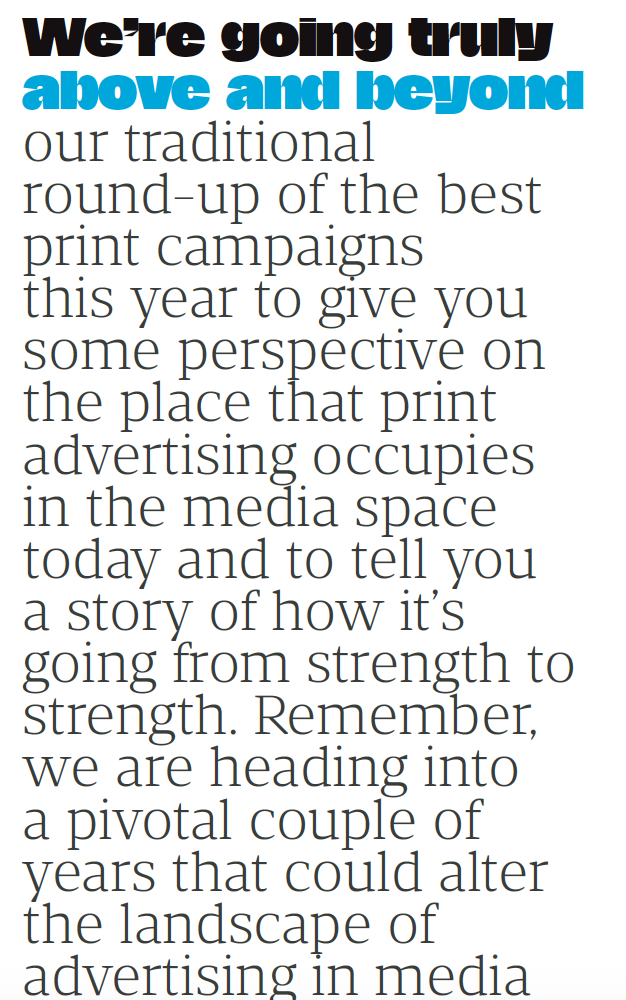
The projected elimination of third-party cookies from Google Chrome by the end of 2024 could virtually end programmatic advertising as a viable revenue stream and brands and publishers across the world are already preparing for a future built on more premium ad sales with first-party data.
There is also evidence that digital clutter might be driving brands to consider, in a fresh way, the power of print. Recently, General Electric took over The New York Times’ print advertising for a day, amounting to 22 full-page colour ads as well as five partial pages. Omnicom-owned ad agency TBWA paid for its ‘Last Ad from
the Last Big Ad Agency on Madison Avenue’ full-page ad in The Times, advertising its move to a different location in Manhattan. In India, advertisers have been aggressively using QR codes in print as the new call to action. In the UK, brands that have been experimenting with print’s unique ability to create awareness, hold attention and drive commercial actions are achieving standout. For example – last year, Confused.com released comic-strip-style print ads titled ‘the Confused.comics’. Created by Accenture Song, the ‘comics’ offered a light-hearted commentary against the increasingly confusing times in the UK.
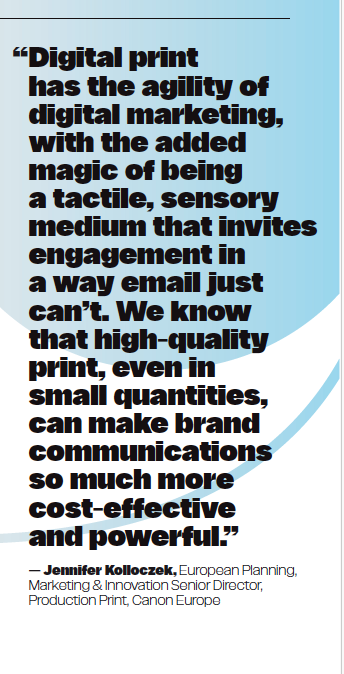
As we survey the landscape now, here’s our attempt, using some stunning examples from this and previous years, to deliver a timely reminder of what print can do for you brand and the various ways in which it can make campaigns and stories come alive. Predictions for the Year Ahead Though the printing market has suffered the effects of the volatility of the past few years, with exceptional increases in the cost of raw materials and energy, leading to sharp price rises in paper, inks and logistics,
print is still very much in the game.
According to Print Power’s report Print Media Predictions 2023, the coming years will be marked by three trends: automation, sustainability and personalisation.
Firstly, automation and process optimisation will continue to play a big role this year in maximising efficiencies across the production chain. From a brand owner and agency perspective, automation enables products to get into stores more efficiently, at a reduced manufacturing cost and with less associated waste. Therefore, brands can be more dynamic and responsive to changing consumer behaviour and selling patterns.
Secondly, the spotlight is on sustainability, as corporate brands put pressure on their print and signage partners to offer more friendly options for out-of-home, event and point of sale graphics and other types of visual communication. Automation plays a major role in reducing waste, but print buyers are also expected to have more consideration for the technologies and inks being used to produce their products, and the materials they’re made out of. Working towards their goals of sustainability, HH Global, leader in tech-enabled creative production and procurement and global leader in sustainability capabilities, have created its own proprietary software that measures CO2. Everything passes through what’s called its sustainability hub, which has externally verified data points from environmental databases like ecoinvent.
The third hot topic is personalisation. With creative and technical capability matched by widespread and immediate demand, forward-thinking print businesses have seen the opportunity for individualisation that came with the shift to digital production. Consumers everywhere want experiences that are personalised, instant, and augmented. Brands that embrace personalisation are sharpening their competitive edge. Recognising this, FESPA has launched Personalisation Experience, an experiential showcase and multi-day conference. Geared towards brand owners, marketers and agencies, the event will zone in on how to harness personalisation to enhance or differentiate products in areas including personalised loyalty marketing, sportswear and fashion customisation, and personalised packaging.
CASE STUDIES
Folha Sao Paulo.
Brazil
Brazilian Folha de S. Paulo is a daily newspaper that continues to place print at the centre of its revenue strategy, despite its digital platform enjoying the largest engagement rate in Brazil based on the time readers spend on the website. The print platform represents 64 % of the company’s advertising revenues, its adoption of multiple innovative approaches to print advertising has helped keep it relevant in an increasingly digital age.
As part of its 100th anniversary celebration, Folha took a creative route: it used currency-quality paper and inks to create the world’s “most valuable newspaper.” The idea was that the professional press was so valuable that newspapers should be printed with the same care used to produce money. In short, at a time in which misinformation was rampant, Folha reiterated that quality, reliable information was worth as much as money.
This historical print edition attracted more than 100 advertisers from some of the most important brands, such as MasterCard, Honda and others, and on that particular day, revenues were more than 20 times higher than regular editions. This diverse array of important brands proved not only the power of a legacy brand but also the value of print these days.

Indeed, such innovation and capabilities make newspapers more valuable to advertisers — and more attractive to agencies. According to Marcelo Benez, chief commercial officer at Folha, it’s all about what one can offer. “If you talk to the people who are working today in advertising and up to a certain level of seniority, the main question is what can news brands offer?” he asks. “Well, they offer extended creativity.”
Print also affords companies the flexibility to innovate with things that cannot be accomplished on the digital realm, resulting in the creation of print ads that are nothing short of works of art. The Super Giant Folha is one example, an ad composed of 20 standard pages, back and front, which together created a super-sized graphic with major impact In addition, Folha uses print ads to complement
digital offerings such as podcasts. A campaign for Audi, for instance, used print to promote the luxury carmaker’s podcast. Among its most innovative campaigns, however, was what Folha did for Earth Day in 2021. Making a strong statement against global warming, the paper’s advertiser JBS worked to transform the print edition by turning it blue, signifying the pressing need to make the climate crisis a top priority in journalism, policy, and everyday choices.
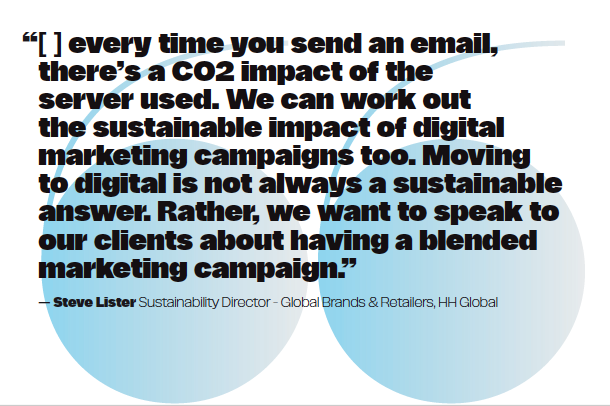
Stuff
New Zealand
New Zealand’s Stuff attracted the attention of advertisers by repositioning print as a premium. According to Steve Hutton, group sales director, the company offers “practical solutions to help generate ad revenue growth by bringing print to the forefront of our creative thinking across our markets”.
In 2020, Stuff launched a print advertising competition, Paper Planes, to allow creative agencies and brands to show the power of print and how it can be used in advertising, and to give the Stuff brand a lift. It hoped, through the campaign, to engage with key ad partners, activate them to deliver print campaigns, and ultimately generate industry discussion around the creativity of print and drive it forward.
Paper Planes invited entries from all creative agencies in New Zealand and had two categories: best print concept and best digital extension. Winners received US$327,000 worth of advertisement across Stuff’s entire product line. The competition has been wildly successful; offers command triple-digit price premiums and have contributed dramatically to Stuff’s commercial performance.
An example of an advertisement carried by Stuff for Hyper Ride shows perfectly the power of the newspaper. To address the issue of online retail sizing through print, the advertisement allowed for users to place their foot on the newspaper to ascertain their foot size. This not only tickled audiences but proved enormously useful; a foot cannot be placed on a laptop or phone.
Bild
Germany
According to Bild’s managing director Andreas Conradt, print comprises 89% of newspaper revenue in Germany. Capitalising on the fact that the majority of readers in the country find online advertising annoying and that print benefits from advertising and journalistic content being viewed at the same time, Bild has leveraged the print medium to create unique advertising experiences. “Print can do things that you cannot do with digital advertising,” says Conradt, as their latest record shows. The German tabloid, published by Axel Springer, has pioneered a new advertising concept it calls megapanoramic ads, now a standard offering used successfully with other advertisers. In 2019, for the 50th anniversary of the Berlin TV tower, the editorial team set out to create a world record with the largest infographic ever printed in a daily newspaper. With Ferrero onboard as a sponsor, Bild’s technical experts glued three pieces of newspaper together to create a printed field that spread across six Nordic pages, with a total length of 2.35 metres (92 inches). Then, the image, resembling a big poster, was inserted into the newspaper. This concept was also replicated on the 35th anniversary of the Mercedes-Benz car factory.
Bild is an example of a company that firmly believes in the relevance and popularity of print even in a digital world. Conradt believes that good quality print will always be welcome, and that its reach is incomparable. “Of course, you can sneak into customers’ households through digital ways, but you cannot distribute computers, tablets, or smartphones for free,” he says.
ADS THAT LEVERAGE THE VERY PHYSICALITY OF PRINT
1- High-Functining Print go Outside
Brazil
With the pandemic marked by lethargy and increased indoor time, and races and trail runs in Brazil having been cancelled, runners needed motivation to get back on their feet once restrictions eased.
To inspire its subscribers to return to exercise, Brazil’s outdoor adventure magazine Go Outside took the physicality of print to the next level. Occupying a full page, “Take this ad for a run” had a race-official running number unique to each subscriber
2- Change the Ref
United States
The physicality of print was also central to Change the Ref’s antigun message, literally shoving the message directly into people’s hands.
At first glance, a series of infographics showed the extent of how fireams are responsible for suicide and teenager and domestic violence death rates in the US. However, readers could turn the ad around and see the death stats ominously turn into the shape of a gun. The art direction communicated serious statistics without the copy needing to be read too carefully. The powerful campaign let the reader feel the heavy burden of holding a gun, and also served as a grim reminder that guns are behind some of the most horrific data points in the US. This campaign would not have worked on any other medium, reinforcing the power of print in driving home messages.
PRINT AS A TOOL TO UPHOLD DEMOCRACY – AN.NAHAR
In a laughable but serious stalling tactic, the Lebanese government sought to cancel the 2022 elections citing shortage of paper. However, newspaper An-Nahar set out to defend the ideals of democracy. Together with agency BBDO Dubai, they stopped the press for the first time in 88 years. Instead, they ‘released’ the Elections Edition, a simple message displayed on an empty newsstand that declared the elections would happen no matter what. Paper from the unprinted edition was sent
to the government to print voting ballots, and readers could access an online edition via a QR code. In an impactful move that proves that evenan unprinted newspaper holds the power to transform, the organisation prioritised donating ink and paper over printing their edition, reiterating the cultural, political and social relevance of the print medium. Additionally, the online edition became the highest read in the history of the paper.
USING PRINT TO GAIN CONSUMERS – TRUST
When brands want consumers to hear (and trust) what they’re saying, they use print. Ulbe Jelluma, managing director of Print Power Europe, believes that the
fact that brands — including digital ones — turn to print when they want to get their message across speaks volumes. “When you want to say something important, you say it in a newspaper,” he says in the INMA report titled The Power and Promise of Print
Advertising. He refers to three specific examples of how brands turn to print. In one of the most talked-about ads in recent years, KFC, in 2018, apologised to customers after running out of chicken during the pandemic. The shortage caused the fast-food chain to shut down some 900 outlets in the U.K., and the company responded with a full page ad in the Sun and Metro newspapers. The ad showed an empty bucket of chicken surrounded by crumbs and, instead of the familiar
KFC logo, the letters were transposed to read “FCK.” In addition to explaining what happened and offering an apology, the company thanked customers for “bearing with us” and received resounding approval on social media.
Similarly, an ad from Facebook attacked Apple for its privacy position. Facebook publicly criticised Apple’s iOS privacy changes in full-page newspaper ads. “We’re standing
up to Apple for small businesses everywhere,” read the headline on an ad inside The New York Times, the Washington Post, and the Wall Street Journal. Thee ads were related
to Apple’s iOS 14 privacy changes that would make it more difficult for companies like Facebook to target users with ads.
A few days after rolling out its new privacy policy for WhatApp, the Facebook-owned messaging service put out full-page ads in leading English-language dailies such as the Hindu, Indian Express, The Telegraph, Deccan Herald and the Times of India titled “WhatsApp respects and protects your privacy”.
ADVERTISING A BRAND + A LARGER MESSAGE
By taking a bolder approach and discussing topical social and environmental issues in print-based ads in unexpected ways, brands let readers know that they have strong core values that help to keep them in the forefront of their target audience’s minds. Here are some examples:
DOVE REVERSE SELFIE
Underscoring the trustworthiness of print as a channel, Dove’s campaign uses the long-established integrity of print to shine a light on the damaging effects of unrealistic beauty standards among the younger generation – a problem significantly escalated by mobile and social platforms. Responding to the disturbing level of distortion in apps causing selfie dysmorphia, a rise in cosmetic surgery and teen suicides, Dove addressed the self-esteem crisis by photographing real girls aged nine to 13 and showing images of their natural selves alongside their own heavily manipulated shots. To its target audience – most likely parents – the contrast was startling, and the pressure felt by millions of girls daily to look certain ways was brought to the fore.
In a massive endorsement for print’s reach and impact, the campaign got 6 billion earned impressions, inspired more than 4000% of their Self- Esteem Toolkit downloads and
created 99% positive sentiment.
MCDONALD’S: TAKE AWAY YOUR TAKEAWAY
In 2022, McDonald’s took ownership of the fact that its packaging accounts for a significant amount of littering in Norwegian cities. Its Take Away Your Takeaway campaign
sought to encourage lovers of the fast-food chain to be accountable and reduce littering. This utilised photography of discarded Mcdonald’s packaging on the streets of Oslo and simple, to-the-point copy: “Unfortunately too much of our packaging ends up on the streets. Now we’re doing our biggest effort yet and will clean even more than we already do.”
Combining print, social media, out-ofhome displays and McDonald’s trays, Take Away Your Takeaway is a prime example of a brand speaking out on issues facing the community and environment and using its influence to spark real change. The striking yet unpolished photography exposes the reality of the issue and the sincere, concise messaging speaks to the authenticity of the message.
IKEA
With shocking stats showing that in Norway alone, over 3 million pieces of furniture ended up in landfill, IKEA knew it needed a message to drill home this grim reality.
Ikea created The Trash Collection in 2021 – an upcycled range of products made out of actual IKEA trash. The brutally honest print campaign showed landfill alongside the new collection.
The ad copy linked to an online page telling customers how to take better care of their IKEA furniture. The creative highlights discarded Ikea products and says where they were found, what was done to refurbish them to working order, and their secondhand price compared with the original. The items are also highlighted on the campaign website, where visitors can find out how to order spare parts for Ikea items, learn more about Ikea’s buy-back scheme and get price quotes for specific pieces of furniture,
and read about Ikea’s pledge to achieve zero waste and become 100% circular and climate-positive by 2030.
In the campaign, IKEA acknowledges being part of a bigger environmental problem and so is creating a sustainability programme. Using printed material in fun ways… In 2021, to combat Berliners’ famous crabbiness around the holidays, and to help customers navigate the chaos of Christmas commuting, Berlin’s public transport operator BVG came up with an edible ticket infused with hemp oil.
THE PORTUGUESE (RE)CONSTITUTION
With the Carnation Revolution’s 50th anniversary looming, Penguin Books looked to educate younger generations using the very instrument used for censorship – the blue pencil. Agency FCB Lisbon commissioned a group of artists to reinvent the fascist constitution with illustrations and poems using words selected from the historical document. They were tasked with employing a technique called ‘black-out poetry’ to create something new and beautiful by selecting words from the oppressive text and blocking out the rest with rich illustrations. Artists were thus given the licence to flip historical documents of subjugation into messages of freedom. Page after page, words were recontextualized amid images ranging from a human heart embraced by two hands to objects that echo Portugal’s erstwhile military regime, like combat boots and guns. By
the end, the works were collected into a book, published in 2022.
The powerful tome resulted in $1million in earned media, becoming a bestseller and now in its second edition. It’s being used in schools – as part of the National Reading Plan — to teach children about the revolution, and is part of collection at the Aljube Museum — a former political prison.
THE POWER OF REACTIVE ADS
Despite the diminishing relevance of print among modern audiences, marketers retain a special place in their hearts for a witty ad contextually placed within newsprint. The layers of trust the medium affords, and the implied effort in getting the comms on to the page, signal to readers a worthy message.
In March 2023, Asda communicated a new vegetable sale policy – comms that should put any reader to sleep, but didn’t. Yet again, a print ad addressing a supply chain issue resonated with people.
Asda, Havas, and Spark Foundry ran the Romaine Calm ad below a news story detailing empty shelves and ministerial incompetence. Asda navigated the issue with a memorable pun that flowed from print into social and online. The creators believe comms like this that are reassuring are important and help to stem feelings of panic in fractious times.
Starcom’s commercial display director Nick Brown, also sees benefit for the newspapers. “Newspapers love the opportunity to run reactive activity because they get PR benefits and it looks great on the printed page, which makes them very amenable to work with.” It is vital the ad sits next to a relevant story so readers make the instant connection.
THE INDIAN CASE: TIMES OF INDIA
It is vital to keep in mind geographical and cultural differences in how print is perceived. Says Ulbe Jelluma, managing director of Print Power Europe in an INMA report “We need to keep in mind that yes, [print] might be in a very difficult situation in the US, but that is not the case in other markets.” Overall, print is alive and well. “If we look at the percentage of revenues by sources, 56% of all the revenues of newspapers are still related to either print, print circulation, or print advertising,” he says.
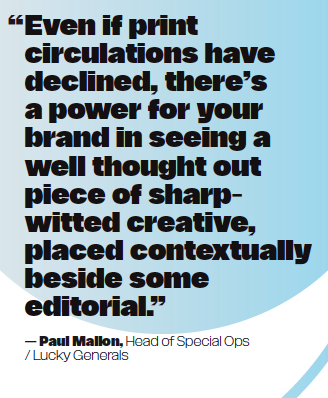
India is one of the regions in which print remains an important revenue stream for newspapers. Print sales have risen 27% at Times of India in two years and between April 2020 and March 2021, 1,097 new publications were registered in India. In 2021, print revenue grew 39% and, based on current numbers, print in India is projected to have grown 13% in 2022. In India, advertisers leverage print 14 times more than mediums such as television, social media, and other digital platforms.
Malcolm Raphael, senior vice president at Times of India Group in Mumbai, India, believes innovation in print is the most impactful way to announce a product launch, differentiate the brand from peers, and make competition and consumers sit up and take notice. Advertisers are increasingly beginning to recognise that a print innovation, when done right, also feeds into organic virality on social media.
A slow reveal of content encourages people to keep learning more. Innovations, Raphael believes, will play a crucial role in maintaining the engagement quotient with the print
medium and ensuring its relevance in a rapidly evolving technology-driven marketplace. “It creates high impact and enhances brand engagement with the message, resulting in higher recall and shareability,” he says in an INMA blog.
INNOVATION IN PRINT (offbeat)
In 2021, the Times of India Kerala celebrated its 9th anniversary with a special 16-page pull-out, with 24 clients on board. To mark the occasion, an innovation of a cloth jacket was printed on PVC-free polyester recyclable fabric (environment-friendly) using UV inks to produce vibrant colours.
“Innovation has always been in the DNA of The Times of India brand, and as the leader in the English daily category, we have always championed first-of-its-kind initiatives in the print space,” says Partha P Sinha, President, Response, The Times Group. “Such initiatives not only set us apart from the competition but also make the medium as a whole, more engaging for readers and advertisers.”
ACCESSIBILITY/ INCLUSIVITY IN PRINT
In December 2021, Metro joined forces with the Royal National Institute of Blind People (RNIB) to create the firstever Braille cover of a national newspaper.
To promote International Day of Disabled People on Friday 3rd December, the special edition of Metro was distributed in nine major central London locations including travel hubs like Kings Cross station. Over 15,000 copies were picked up by daily commuters, featuring a Braille message letting blind and partially sighted people know that we are on our way to making our world a truly accessible place for everyone.
Metro and RNIB teamed up to bring the issue of accessibility to the forefront of the nation’s mind by transforming the cover of Metro as a simple yet effective way of making the steps towards a more inclusive society for the visually impaired.
The inside cover also featured a QR code for readers to scan and have the opportunity to experience how blind or partially sighted individuals see things
differently, as well as learn what the Braille cover message says.
THE POWER OF TOUCH
PRINT: NOT JUST A CHANNEL, BUT AN EXPERIENCE
Print offers an opportunity for brands to connect with people physically. A recent report by printpower.eu in association with Dr. Andy Myers, Director Walnut Unlimited, highlighted how print advertising can engage attention, memory and emotion. Dr Myers has a PhD in Cognitive Neuroimaging (fMRI) and brings the worlds of neuroscience and market research together to understand what makes successful marketing.

Scientific and neuromarketing studies demonstrate that the sensory nature of print outperforms digital in communicating and embedding key messages, and in long-term brandbuilding. Indeed, the neuroscience of human touch offers a hardwired pathway to harnessing emotion, grabbing attention and embedding memory – all of the objectives brand marketers strive to achieve. Touch causes information about the object’s texture, shape, pressure and weight to be sent to our brain, where it becomes conscious perception. These signals trigger interconnected neural networks, intertwining touch with emotion by activating unconscious memories and feelings.
Brand marketing has three basic things it needs to achieve to be effective, which in turn affect our decision making: capture attention, stimulate emotions, and impact memories. Print does all three.
- Grabbing attention
Feeling the digital fatigue more and more, audiences are increasingly blocking or avoiding digital ads. Reading from a screen is characterised by browsing and scanning, nonlinear reading, keyword spotting and declining sustained attention, causing audiences to feel the digital fatigue more and more. Print, however, is a different story: a 2017 study reported that over 90% of subjects said they concentrated best when reading from print, and over 80% would prefer print for studying and pleasure. This shows that print can not only grab attention, but also hold the audience’s focus. Easier comprehension is also facilitated: a 2019 study showed that a physical page better conveys a sense of narrative; and that sensory feedback from tangibly consuming print allows easier location of events and for the reader to connect with the story. - Stimulating emotions
The centrality of emotion to branding is well researched, with such connections communicating messages more effectively. Print is shown to generate a strong emotional response in readers, with the physical material creating more emotionally vivid connections and memories. This has to do with what researchers call the ‘endowment effect: a common bias where we become attached to an item just by having it in our possession. Brands could capitalise on this strong emotional connection with a simple paper brochure. The texture further intensifies these emotions – studies have shown how people experience different emotional states depending on the texture of a surface. Print enjoys high levels of trust, and consequently fosters deeper emotional connections and builds positive brand relationships. A German study put print second only to the recommendation of friends and family as a trusted source of information, with 54% trusting printed paper and magazine ads compared to just 16% trusting ads online. Meanwhile, a US study showed print ads to be the most trusted type of advertising, with trust levels at a staggering 82%. - Print ads are more “real”:
creating memories Physical ad have been found to create more emotionally vivid memories – crucial for brands looking to develop positive and lasting brand impressions. A study comparing how the brain reacts to the same brand information in a direct mail compared to digital advertising found that the physical format of the direct mail triggered more areas of the brain involved in integrating visual and spatial information. The quality of print ads is also crucial to making memories: research found that almost 80% of people who just looked at high-quality, vivid imagery of popcorn in a print ad were one week later as likely to claim they had eaten the popcorn as people who actually had. With low-quality imagery, however, this figure dropped to 30%.
DRIVING PERCEPTIONS AND BEHAVIOR
Research finds that print advertising is not only more memorable, but also more likely to drive people to buy. A 2015 study demonstrated that when looking at print ads, there was more activity in the brain area associated with reward processing and desirability. In fact, better quality of paper itself leads to the brand being perceived better, with high quality seen as an extension of the brand itself. For premium or luxury brands, the quality of the paper stock used in print executions influences audience sentiment and perceptions of quality.
Research also shows that readers exhibit significantly higher responses in emotional reaction, immediacy of recall, perceived value and subconscious desire for the product
when they see it in print. A neuroscience study by Canada Post bolstered these findings, demonstrating that print requires 21% less cognitive effort from the brain, is more motivating, and more likely to drive behaviour than digital media.
UNLEASHING THE MULTI-SENSORIAL POSSIBILITIES OF PRINT
It’s not just the power of touch. According to sensory brand experience expert and New York Times bestsellin author Martin Lindstrom, a message is up to 100% more impactful
when delivered through three sensory channels than it is when delivered through one. Multi-sensory executions – using smell, taste, sound or embedded NFCs – have the potential to capture attention, drive stronger emotional associations with a brand and in turn embed stronger memories. A brand scent, for instance, can create an immediate, emotional link in the brain between the ad and the product.
And finally, paperbacks at the train station where the idea was invented! A genuine feel-good story to end this chapter and close out this year’s book. The story goes that when Allen Lane (later Sir Allen) popped into the bookstall at Exeter St David in 1934 after a visit to Devon crime writer Agatha Christie, he was despondent at the lack of quality on offer and the high prices.
He set about transforming bookselling, founding Penguin, the famous paperback publisher.
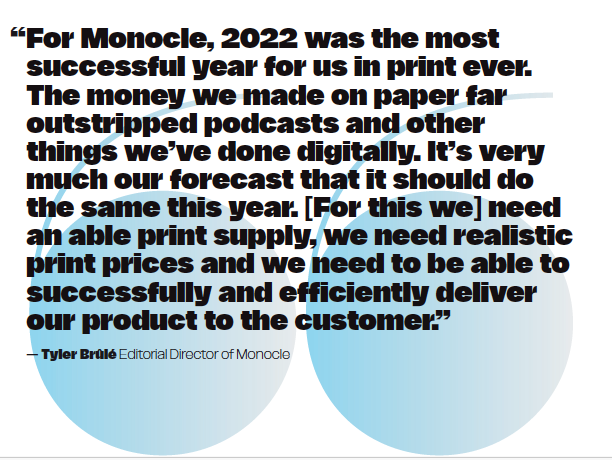
In 2017, according to Radio EXE Devon, his descendents commemorated him with a plaque at Exeter St David at the very spot where he was inspired to create the sixpenny paperback. And now the station has brought back another 1930s’ bookselling inspiration; the paperback vending machine. Better still, profits from book sales from the machine will go towards local Bookbag Bookshop and Exeter City of Literature.
The Innovation in News Media World Report is published every year by INNOVATION Media Consulting, in association with FIPP. The report is co-edited by INNOVATION President, Juan Señor, and senior consultant, Jayant Sriram


